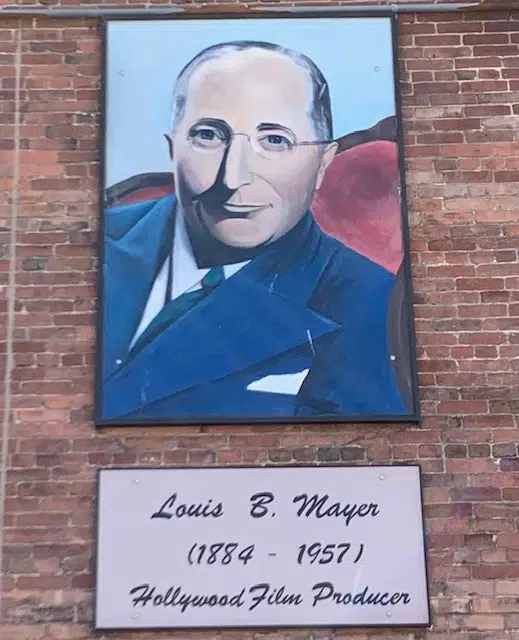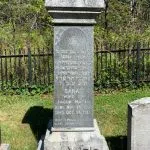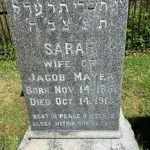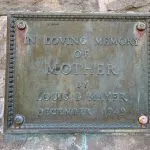
Mural of Louis B. Mayer on Canterbury Street.
This article is the first in a series about New Brunswick entertainment figures who made their mark on Hollywood.
The first Hollywood figure to come out of New Brunswick is one of the industry’s most infamous; Louis B. Mayer (born Lazar Meir), film producer and co-founder, and studio head of Metro-Goldwyn-Mayer Studios (MGM).
Mayer was born July 12, 1884 to Jewish parents in Belarus and the third of their five children. The Mayer family fled Belarus as the result of discriminatory laws against Jews in Russia, and emigrated to Saint John via Long Island, New York in the 1890’s. His father, Jacob Mayer, ran a scrap metal business, J. Mayer & Son, but struggled to earn a living.
“Mayer’s story is of the lowest class and the poorest people in Saint John,” stated Scott Preston, Associate Professor of Culture and Media Studies at the University of New Brunswick. “They don’t often get their stories told, so his life is a great opportunity to shine a light on immigrant experience and growing up.”
Mayer quit school at the age of twelve to help support his family. His work ethic fueled him to become a tireless scrap metal dealer, diving into the Bay of Fundy for scrap and roaming the streets with a cart to collect any metal he came across.
He was drawn to the entertainment business and would frequent the theatre and vaudeville shows in his spare time. After moving to Boston in 1904 he bought and transformed a former burlesque theatre in nearby Haverhill and turned it into his first movie theatre, “The Orpheum.” Mayer steadily purchased and refurbished theatres while emphasizing quality and class. He cemented his position as a top dog of cinema by purchasing for $25,000 USD ($633,891.09 USD in 2019) the northeastern U.S. distribution rights to D.W. Griffith’s The Birth of a Nation in 1915.
“[He] undoubtedly had a sense of popular taste and what made something good, what made something good as a story or a piece of entertainment…he was a showman,” said Preston.
In 1916, Mayer partnered with producer Richard A. Rowland to create a talent booking agency, Metro Pictures Corporation. Two years later, he moved to Los Angeles and created his production company, Louis B. Mayer Pictures Corporation. In 1924 the two companies and producer Samuel Goldwyn’s Goldwyn Pictures Corporation were purchased by Marcus Loew, owner of Loew’s theatre chain, to become Metro-Goldwyn-Mayer Studios. Mayer was named Head of Studio Operations and cemented his spot as one of the “Big Six” movie moguls of the Golden Age of Hollywood. Mayer eventually became Head of Production – and the first person in America to earn a million-dollar paycheck.
Over the next twenty-five years Mayer cultivated MGM into “the Tiffany of the studios” and created the star system that defined Hollywood.
“Mayer maintained a balance, almost a mixture of fear and respect. A lot of people saw him as a father figure. But a father figure can be unpacked in so many different ways; containing both fear and admiration and also love” said Preston. MGM was home to the brightest stars, including Greta Garbo, Clark Gable, Judy Garland and Elizabeth Taylor; at MGM there were “more stars than there are in Heaven.”
Mayer’s taste for class, glamour and sentiment influenced MGM’s films, which served as delicious escapism during the Great Depression. In fact, MGM was the only studio to not lose money, file for bankruptcy or undergo major reorganization in the 1930’s while producing over fifty films per year. The Wizard of Oz (1939) and Gone With the Wind (1939), two classic films that have come to define Hollywood and the film industry, were produced by MGM under Mayer, with MGM’s specialty being lavish musicals. Meet Me in St. Louis (1944), Show Boat (1951), An American in Paris (1951), Singin’ in the Rain (1952), and Guys and Dolls (1955) are examples of musicals made during Mayer’s lifetime that thrilled audiences with their singing, dancing and technicolor sets.
Mayer had a reputation for being ruthless and quick to anger and could rule the studio with an iron fist, rewarding fealty and swiftly punishing defiance; he was the mogul the other moguls were afraid of.
“The way we as a culture and society are rethinking sexual politics in the media industries and in Hollywood, all of those subjects are touchy and difficult things to address, and I think sexual politics are the one where we might now write a new history of Hollywood,” stated Preston. “That has not really been done yet, to look at the Classical Hollywood period through the lens of the ‘MeToo’ movement.”
The men who ran the studios were the kings of their castles, known to abuse their power in business and “casting couch” scenarios. In coverage of the growing “MeToo” movement in October, 2017 The Telegraph and Variety revisited allegations that Mayer groped a teenage Judy Garland, and referring to Garland as his “little hunchback” and manipulated her mental and physical health and personal life. He also obsessively pursued actress Jean Howard and when she married agent Charles Feldman, he banned Feldman from MGM and refused to hire any of his clients for MGM pictures.
Mayer died of leukemia on October 29, 1957 at the age of 73. He was interred in the Home of Peace Cemetery in East Los Angeles, California. As detailed in exhibitions held by the Saint John Jewish Historical Museum, his mother, Sarah Meltzer, is buried in the Shaarei Zedek Cemetery in Saint John.
- Sarah Meltzer’s grave
- Close up of Sarah Meltzer’s grave
- Plaque dedication to Sarah Meltzer
Her death deeply impacted Mayer and he donated money, (as did his cousins Nathan and Max Cummings) for the construction of a memorial chapel in dedication of their mothers in 1950. The women, who were sisters, are buried side-by-side along the back fence of the cemetery.
With files from the Saint John Jewish Historical Museum and Scott Preston, Associate Professor of Culture and Media Studies at the University of New Brunswick.






